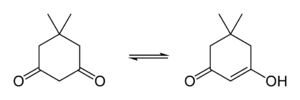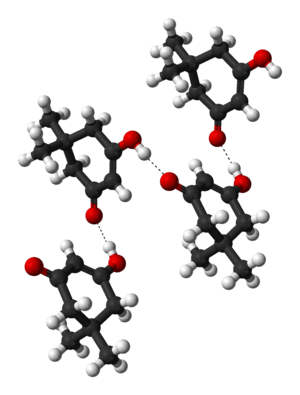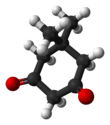Dimedone
Dimedone is a cyclic diketone used in organic chemistry to determine whether a compound contains an aldehyde group. Cyclohexanediones in general can be used as catalysts in the formation of transition-metal complexes. Other uses include applications in colorimetry, crystallography, luminescence and spectrophotometric analysis. It can also be used for chemistry involving organic compounds of low electrical resistance.
| |||
| Names | |||
|---|---|---|---|
| IUPAC name
5,5-Dimethylcyclohexane-1,3-dione | |||
| Other names
Cyclomethone, 5,5-dimethyl-1,3-cyclohexanedione, Dimethyldihydroresorcinol, Methone | |||
| Identifiers | |||
3D model (JSmol) |
|||
| ChemSpider | |||
| ECHA InfoCard | 100.004.369 | ||
PubChem CID |
|||
| UNII | |||
CompTox Dashboard (EPA) |
|||
| |||
| |||
| Properties | |||
| C8H12O2 | |||
| Molar mass | 140.17968 | ||
| Appearance | Yellow crystals | ||
| Melting point | 147 to 150 °C (297 to 302 °F; 420 to 423 K) (decomposes) | ||
Except where otherwise noted, data are given for materials in their standard state (at 25 °C [77 °F], 100 kPa). | |||
| Infobox references | |||
Synthesis
Dimedone is prepared from mesityl oxide and diethyl malonate.[1]
Physical properties
Dimedone usually comes in the form of white crystals. It is stable under ambient conditions and soluble in water, as well as ethanol and methanol. It has a melting point range of 147–150 °C (420–423 K).
Tautomerism
Dimedone is in equilibrium with its tautomer in solution — in a 2:1 keto to enol ratio in chloroform.[2]

Crystalline dimedone contains chains of molecules, in the enol form, linked by hydrogen bonds:[3]

References
- R. L. Shriner and H. R. Todd (1935). "5,5-dimethyl-1,3-cyclohexanedione". Organic Syntheses. 15: 16. doi:10.1002/0471264180.os015.06.
- Clayden, Jonathan; Greeves, Nick; Warren, Stuart; Wothers, Peter (2001). Organic Chemistry (1st ed.). Oxford University Press. p. 532. ISBN 978-0-19-850346-0.
- M. Bolte and M. Scholtyssik (October 1997). "Dimedone at 133K". Acta Crystallogr. C. 53 (10): IUC9700013. doi:10.1107/S0108270197099423.

